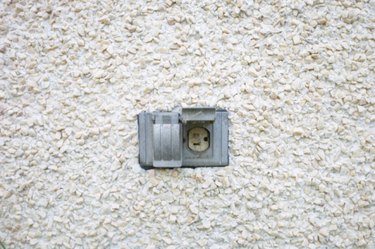Things You'll Need
Flat-head screwdriver
Lockable weatherproof bubble cover
Padlock

Preventing the unauthorized use of an exterior outlet is easily accomplished with outlet covers that are lockable. The latest National Electrical Code rules, 406.8(B) Wet Locations, requires exterior outlets to have a cover that can close with a cord plugged into the outlet. Older houses and commercial properties may have weatherproof covers that cannot be closed while a cord is plugged in. Replacing the cover with a lockable bubble cover will solve the problem. Most home improvement stores have these covers in stock and are fairly inexpensive.
Step 1
Inspect the existing outlet and cover. When purchasing your new lockable bubble cover, be sure that the cover is designed to be installed in the direction of the outlet. Some covers only work if installed in one direction, horizontally or vertically depending on the cover.
Video of the Day
Step 2
Remove the screw or screws holding the old weatherproof cover onto the outlet. Pull the old cover off along with the gasket behind it.
Step 3
Locate the proper insert for the existing outlet. The bubble covers generally come with several different inserts. The inserts are designed for specific styles of outlets and switches.
Step 4
Slide the correct insert into the bubble cover from inside of the door. Put the new gasket that came with your bubble cover over the existing outlet; you may need to remove the perforated sections for the style of outlet in use. Place the bubble cover over the outlet, and install the screws to hold it in place and tighten them down.
Step 5
Purchase and install a padlock that has a narrow enough bar to fit through the hole in the lockable cover.
Tip
Installing the lockable bubble cover should keep most people honest. The fact that bubble covers are made of plastic makes them easy to break off. If the outlet is in an unsupervised area it could become an issue. There are metal covers that are lockable but not when a cord is plugged in. This may be a better choice than the plastic cover if in a remote area.
Warning
Electrical work should only be done, or at least supervised, by a qualified electrician. The changing of a cover should be straightforward, but be careful not to touch the screws on the outlet while working on it to avoid electric shock.
Video of the Day